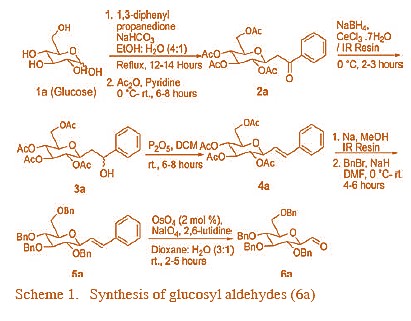Synthesis of Biologically relevant Β-Linked Hetryl C-Glycosides Using 1-Formyl Glucal
Main Article Content
Abstract
This chapter focuses on synthesizing biologically relevant β- linked hetryl C-glycosides using 1-formyl glucal. Glycals have many uses in synthetic carbohydrate chemistry. They are commonly used as glycosylation donors, meaning they can react with other monosaccharides to form a longer chain of monosaccharides called oligosaccharides. Glycals can also have interesting applications in studying biological systems, particularly enzymes. Glycoconjugates play a significant role in cell recognition processes and this has prompted the synthesis of many glycoconjugates via the glycal methodology. The presence of unsaturation and C-1 substitution make them good substrates in several reactions. In recent years C-1 functionalized glycals have emerged as key carbohydrate precursors in a variety of synthetic transformations leading to carbohydrate mimetics. In such compounds broad structural variations are possible due to the presence of α-β unsaturation, offering the potential for improving drug metabolism and pharmacokinetic properties.
Article Details

This work is licensed under a Creative Commons Attribution-NonCommercial-ShareAlike 4.0 International License.
References
Marsault, E. & Peterson, M. L. (2011). Macrocycles are great cycles: applications, opportunities, and challenges of synthetic macrocycles in drug discovery. J. Med. Chem., 54: 1961–2004.
(a) Wells, J. A. & Mc Clendon, L. (2007). Nature, Reaching for high-hanging fruit in drug discovery at protein–protein interfaces, 450: 1001–1009. (b) Horswill, A. R., Savinov, S. N. & Benkovic, S. J. (2004). A systematic method for identifying small-molecule modulators of protein-protein interactions. Proc. Natl. Acad. Sci. U.S.A., 101: 15591-15596.
(a) Driggers, E. M., Hale, S. P., Jinbo Lee, J. & Terrett, N. K. (2008). The exploration of macrocycles for drug discovery--an underexploited structural class. Nat. Rev. Drug Discovery 7: 608 – 624. (b) Wessjohann, L. A., Ruijter, E., Garcia-Rivera, D. & Brandt, W. (2005). Mol. Diversity, 9: 171–186. (c) Butler, M. S. (2005). Natural products to drugs: natural product derived compounds in clinical trials. Nat. Prod. Rep., 22: 162–195.
Veber, D. F., Johnson, S. R., Cheng, H. Y., Smith, B. R., Ward, K. W. & Kopple, K. D. (2002). Molecular properties that influence the oral bioavailability of drug candidates. J. Med.Chem., 45: 2615 – 2623.
Danishefsky, S.J., Mc Clure, K.F., Randolf, J.T. & Ruggeri, R.B. (1993). A Strategy for the Solid-Phase Synthesis of Oligosaccharides. Science, 260 (5112): 1307–1309.
Sigman, D.S. (1992). The Enzymes Vol. XX (FEBS Letters) Mechanisms of Catalysis. Academic Press, San Diego. ISBN 0-12-122720-0.
Liang, J., Hung, D. T., Schreiber, S. L. & Clardy, J. (1996). Structure of the Human 25 kDa FK506 Binding Protein Complexed with Rapamycin. J. Am. Chem. Soc., 118: 1231-1232.
Pettit, G. R., Kamano, Y. & Herald, C. L. (1986). Antineoplastic agents, 118. Isolation and structure of bryostatin 9. J. Nat. Prod., 49: 661–664.
Smith, A. B., Mesaros, E. F. & Meyer, E. A. (2005). Total Synthesis of (−)-Kendomycin Exploiting a Petasis−Ferrier Rearrangement/Ring-Closing Olefin Metathesis Synthetic Strategy. J. Am. Chem. Soc., 127: 6914-6949.
Smith, A. B., Risatti, C. A., Atasoylu, O., Bennett, C. S., Liu, J., Cheng, H., Dyke K. T. & Xu, Q. (2011). Design, synthesis, and biological evaluation of diminutive forms of (+)-spongistatin 1: lessons learned. J. Am. Chem. Soc., 133: 14042-14053.
Albert, M., Dax, K. & Ortner, J. (1998). A novel direct route to 2-deoxy-2-fluoro-aldoses and their corresponding derivatives. Tetrahedron, 54: 4839-4848.
Konstantinović, S., Predojevic, J., Gojkovic, S., Pavlovic, V., Csanádi, J. (2001). The Ferrier rearrangement as the key step in the synthesis of C7–C16-alkyl 2,3-dideoxy glucosides from glucose and C7–C16-alkanols. J. Serb. Chem. Soc. 66: 499–505.
Maiti, D.K., Halder, S., Pandit, P., Chatterjee, N., Joarder, D.D., Pramanik, N., Saima, Y., Patra, A & Maiti, P.K. (2009) Synthesis of Glycal-Based Chiral Benzimidazoles by VO(acac)2−CeCl3 Combo Catalyst and Their Self-Aggregated Nanostructured Materials. J. Org. Chem., 74: 8005-8496.
Mishra, S., Roy, S., Ghosh, R., Dey, D. & Hazra, B. (2020). J. Indian Chem. Soc., 97, 197-211.
Hili, R. & Yudin, A.K. (2006). Making carbon-nitrogen bonds in biological and chemical synthesis. Nat. Chem. Biol. 2: 284-287.
Khatri, V., Kumar, A., Singh, B., Malhotra, S. & Prasad, A.K. (2015). Synthesis of β-C-Glycopyranosyl Aldehydes and 2,6-Anhydro-heptitols. J. Org. Chem. 80: 11169-11174.
Arya, A. & Khare, N. K. (2019). Unpublished work.
